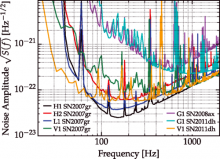
Abstract
We present results from a search for gravitational-wave bursts coincident with two core-collapse supernovae observed optically in 2007 and 2011. We employ data from the Laser Interferometer Gravitational-wave Observatory (LIGO), the Virgo gravitational-wave observatory, and the GEO 600 gravitational-wave observatory. The targeted core-collapse supernovae were selected on the basis of (1) proximity (within approximately 15 Mpc), (2) tightness of observational constraints on the time of core collapse that defines the gravitational-wave search window, and (3) coincident operation of at least two interferometers at the time of core collapse. We find no plausible gravitational-wave candidates. We present the probability of detecting signals from both astrophysically well-motivated and more speculative gravitational-wave emission mechanisms as a function of distance from Earth, and discuss the implications for the detection of gravitational waves from core-collapse supernovae by the upgraded Advanced LIGO and Virgo detectors.